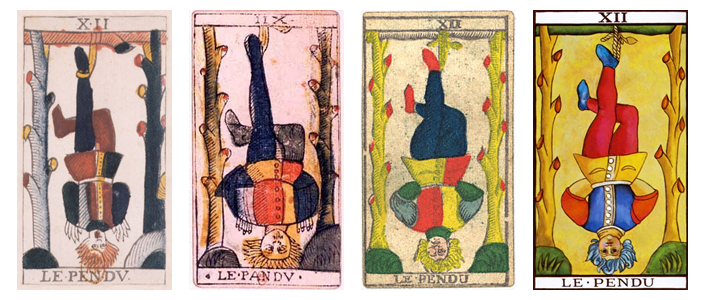Hanged Man - Lamed
A man hangs upside-down from a tree. This image invokes a double symbolism because of the shape made with the legs of the central character. The two symbolisms invoked are the rune discovery of Wotan, who hung upside-down for nine days before receiving the runes; and the crucifixion of anthropomorphic solar diety, who was hung from a tree (wood formed in the shape of a cross – the shape created by the position of the central figure's legs).
The name of the twelfth character of the ancient alphabet is linked to the twelfth hieroglyphic symbol of the Tarot. The original design of this character (pre-1200 B.C.) looks like this...
![]()
This letter is the precursor to the modern letter L. The name of this letter is the word למד, which is constructed from the triliteral stem that consists of the letters Lamed/D, Mem/M, and Daleth/D. This stem has the primary meaning of “to discipline,” and from this meaning, the more common meaning of “ox goad” is derived.
Core Essence
The central theme presented in this iconic hieroglyph are those of discipline, aescetism, and the divine inspiration that comes with a combination of these two things that is made possible due to the small amount of kundalini that rises partially and temporarily with the inferior ascension techniques of aesceticism and discipline that involve breathing techniques and hatha yoga postures. These lesser techniques, while popular in many cultures, still fall far short of the advanced techniques that involve temporary periods of celibacy followed by tantric technique and ritual.
There appears to be many commonalities with the two main symbolisms presented by the central figure of the hanged man icon. The first is that in both symbolisms (i.e. that is, Wotan and the crucifix), self-sacrifice is made as the ox-goad of discipline requires that pain be endured. It is the deep emotional purging made possible by the pain that continually makes its presence felt over and over again that allows for the mind to stretch further and further into the collective unconsciousness and harvest potential gifts of knowledge in the form of divine inspiration. Both excursions symbolized are relatively brief, each lasting only a few days.
The Noblet version of the Tarot de Marseille

There is also the symbolism of temporarily activated kundalini energies that is represented by the hanging upside-down that allows for the bloodflow to increase its downward momentum now that it has gravity as an aid and not as an opposition. This reversed motion of the flow could be seen as a type of symbolic theme that expresses the same type of concept of the process that occurs when kundalini arises above the bramagranthi within the tailbone chakra. The shocked expression and opened hands of the central subject of this Tarot icon could also be expressing the intense sensation of the ascended kundalini frequencies in addition to the divine revelations made possible by this ascension.
Also, it should be noted that only in the Noblet version of the Marseilles Tarot, does this central figure of the Hanged Man trump possess unbound arms and hands. Almost every other version of the Marseilles Tarot depicts a hung man with arms bound, along with most other popular and time-tested versions (not counting the plethora of decks that began to proliferate in the latter portion of the twentieth century). The Rider-Waite Tarot also displays the hanged man with bound hands. Here is another important distinction in the symbolisms presented by the Noblet deck that differ greater from all other known decks. Couple with this fact, the fact that the Noblet deck is the oldest known deck with the the established system of 22 trumps in the Major Arcana, and it becomes clear that some very central themes were obscured – either accidentally or deliberately – in the later deck designs that were to follow, which is why the images from the Noblet deck should recieve the most observational attention.
One speculation as to why the hands are bound in the later decks is that the later artists that used the Noblet or Dodal deck for guides misinterpreted the drawing and mistook the opened hands (reference the hands of the minions from the Noblet Pope trump) of the Hanged Man to be the shoulder tassles of some type of uniform instead of being the fingers of opened hands. While the Dodal seems to retain the essence of the Noblet (at least on one arm), the Conver diverges from it. The Conver omits the finger/tassles and then uses two colors for the sleeves of the Hanged Man's garments, thus giving the appearance of the arms being bound, which then took over as the primary perception of this trump for the next several centuries.
However, due to the overabundance of this particular trait, it is worth noting why such an obscuration would or might have occurred, especially since the exact same change was also made to the Rider-Waite Tarot. The basic symbolism shifts dramatically to an individual who is empowered and can release himself at any moment, to an individual who in unable to change his predicament, unless some type of Houdini-like maneuver is performed. Couple with this unmaneuverable ability of the upper limbs the explession of wonder and shocked enlightenment, and the over essence of the entire image presented on this particular icon of the Tarot is changed significantly.
Basically, instead of empowerment, like the original theme of the Noblet image, the theme becomes more like that of imprisonment with an uncertain promise of intuitive empowerment. Why would this shift have occurred at all, and why would the less attractive of the two options prevail over the centuries? The answer probably lies somewhere within the logic of the assertion that states that the basic nature of most individuals would not care to realize that it is possible to unleash higher powers of the intuitive realms in much the same way that Wotan discovered the runes. Hard mental labor that requires deep thought and soul-searching contemplation is not an option that appeals to most; thus, the image of the bound arms provides a ready excuse for not attempting such aescetic measures.
The Hanged Man of the Rider-Waite Tarot

The interpretation provided by Waite is a type of hybrid of these two explanations. The image of the Rider-Waite Tarot does depict bound hands, yet does display illumination issuing from the subject's head in a manner similar to the Noblet deck. In the accompanying text of the Rider-Waite deck, A. E. Waite states, “The gallows from which he is suspended forms a Tau cross, while the figure--from the position of the legs--forms a fylfot cross. There is a nimbus about the head of the seeming martyr. It should be noted (1) that the tree of sacrifice is living wood, with leaves thereon; (2) that the face expresses deep entrancement, not suffering; (3) that the figure, as a whole, suggests life in suspension, but life and not death. It is a card of profound significance, but all the significance is veiled. One of his editors suggests that Éliphas Lévi did not know the meaning, which is unquestionable nor did the editor himself. It has been called falsely a card of martyrdom, a card a of prudence, a card of the Great Work, a card of duty; but we may exhaust all published interpretations and find only vanity. I will say very simply on my own part that it expresses the relation, in one of its aspects, between the Divine and the Universe. He who can understand that the story of his higher nature is imbedded in this symbolism will receive intimations concerning a great awakening that is possible, and will know that after the sacred Mystery of Death there is a glorious Mystery of Resurrection.”
It is within the last sentence that this interpretation somewhat matches the interpretation that was first presented in this section, and that is, with the death of many undesirable qualities comes the resurrection of new assets gleaned from the newly empowered intuitive abilities. However, the overall interpretation draws a distinction between the sacrifice required and the reward of a great awakening. Therefore, it might appear that Waite is attempting to gather the benefits of enhanced intuitive abilities without the severe aesceticism that is generally required in order to gain these awakenings. In regards to the reference to Eliphas Levi, it would be prudent to quote Levi's statement in regards to this matter which asserts, “Symbol, a man hanging by one foot, with his hands bound behind his back, so that his body makes a triangle, apex downwards, and his legs a cross above the triangle. The gallows is in the form of Hebrew TAU, and the two uprights are trees, from each of which six branches have been lopped. We have explained already this symbol of sacrifice and the finished work.”
Therefore, it would seem as though the basic reason for the initial obscuration from the original essence of the Noblet Tarot is merely extended and given a new twist with Rider-Waite that insists that something wonderful can be gotten with little effort. In this extension of the obfuscation, Levi's interpretation – however flawed it may or may not be – is belittled. With the knowledge of the Noblet image and its exact contents, the entire situation makes far more sense, and the excuses presented by Waite seem to echo the excuses of many others.
Such is the nature of mankind that seeks to gain substantial rewards with either little or no effort. The search for free and instant gratification and its promise has been highly exploited by charlatans for centuries. Even the basic premise of alchemy that claims that lead can be turned to gold has been used as an allegory that expresses the basic notion of getting something for nothing. The problem with this idea is that lead is costly. Lead is not “nothing.” Lead is very valuable and hard to acquire, and its development is even more expensive and costly. It is this basic concept that was widely propagated in the first century that destroyed the many aescetic movements that were filled with multitudes of kundalini masters and had been proliferating all over the regions of the Near East. It is – more than likely – the same basic concept that destroyed the intitial message of this hieroglyph.
* * *
BACK * INDEX * NEXT
 |
 |
 |
 |
 |
 |